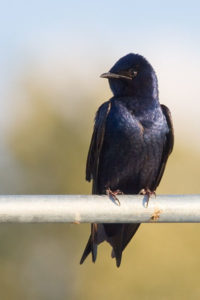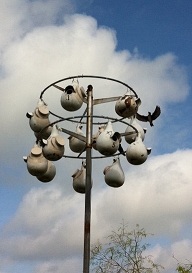Making a Home for Purple Martins
 The Purple Martin is a type of North American Swallow that winters in Brazil and nests all over North America. Every year, a large network of hobbyists note and record the progress of the Martins as they make their way north in search of suitable housing.
The Purple Martin is a type of North American Swallow that winters in Brazil and nests all over North America. Every year, a large network of hobbyists note and record the progress of the Martins as they make their way north in search of suitable housing.
East of the Rocky Mountains, Purple Martins are totally dependent on humans for housing and they tend to prefer man-made nesting everywhere. This is a centuries-old relationship that was begun by the Native Americans, who hung houses crafted from gourds to attract them. Prior to this, Martins probably nested exclusively in abandoned Woodpecker nests and other convenient locals.
Birds that chose to nest near humans benefited from a lack of predators and better housing. It isn’t hard to imagine why Native Americans would have encouraged this symbiosis. Martins are very entertaining to watch, their birdsong is pleasant to the ear and they act as an effective alarm system. Then, as now, their arrival in the early spring marks the beginning of the agricultural season and the final departure of a southbound Martin is a warning that cold days are ahead.

Purple Martins form a monogamous pair for the breeding season and build their nests and raise their young as a couple. As a member of the Swallow family, Martins only eat insects in flight. This results in the joyful sight of their acrobatic feeding but also means that they have less room for error in their household planning.
Sadly, in the nineteenth century, the European Starling and the common House Swallow were introduced to North America from the old world. Both these birds aggressively seek the same nesting sites as Martins and generally drive them out. In order to maintain a Martin colony, the housing must be continuously monitored and protected from these birds as well as snakes and smaller foes like mites. For this reason Purple Martin houses must be constructed with maintenance in mind.
There are two basic types of Martin house: gourd and colony houses. A gourd house can be literally made from a gourd or is a man-made acrylic or plastic house in the shape of a gourd, hollowed out to make a roosting site for one Martin family. The colony houses generally have the appearance of a small apartment building for birds and are mounted on tall poles with a pulley system that allows the entire structure to be lowered for cleaning and inspection. Either type requires a door to block out all other animals during the “off-season” that is removed in January in the Southernmost states (later as you move North).

As with all birdhouses, temperature can be a significant factor. Consequently, most are painted white and have carefully planned ventilation.
Purple Martins are quite picky and a new colony must be prepared with care. The birdhouse must be at least 30 feet from human housing or tall trees. The pole that the house is mounted to must be over 10 feet tall, 20 is better. The site must be otherwise attractive to the Martins, with a source of water nearby and a surplus of high-flying insects. All in all, this is more than a casual hobby.
Although Martins do consume large quantities of insects every day that they are able, they do NOT eat mosquitoes in any quantity. Mosquitoes generally stay close to the ground, preferring shady areas and nocturnal habits, removing them from the Martin’s diet. That said, the freewheeling performance put on by an established Martin colony is an impressive spectacle that can provide hours of backyard entertainment for the careful landlord.
Picture credits: The image of the Purple Martin is from the Wikimedia Commons. It is licensed under the Creative Commons Attribution 3.0 Unported license.





